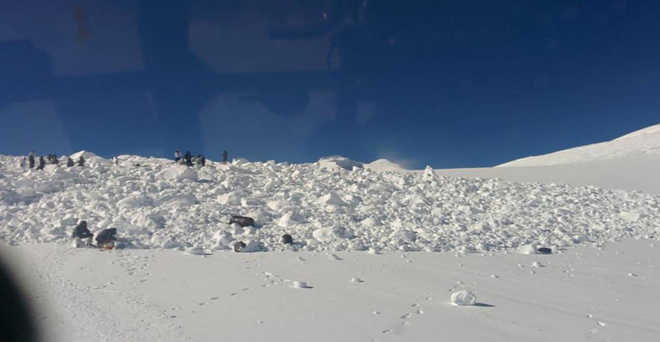
Ten soldiers died in an avalanche at the Siachen Glacier on Wednesday. A Tribune Photo
Ravi Krishnan Khajuria,Tribune News Service,Jammu, February 4
At the Siachen Glacier, the highest battlefield in the world, hostile weather, icy terrain, sub-zero temperature, low oxygen and high-altitude sickness form a lethal mix, taking a heavy toll on men in olive green than any conflict with India’s arch-rival — Pakistan.Pakistan has the same story of losing more men to the weather vagaries than skirmishes between the two countries.As per statistics, 869 soldiers have lost their lives since April 1984 when India initiated “Operation Meghdoot”, airdropping its men to pre-empt a move by Pakistan to occupy the strategic heights.With 10 more Army men falling to an avalanche, the death toll has now gone up to 879 since 1984.The Army and the Air Force have been running against time to trace and rescue survivors, if any, among the 10 soldiers who went missing after an avalanche wiped out an Army camp at a height of 19,600 feet on Wednesday morning.On Siachen’s significance to India and what makes it a dangerous place, Northern Command’s defence spokesperson Col SD Goswami said: “Siachen’s terrain, its strategic location and geographical importance have given it a paramount place in the annals of history. The soldiers deployed on the glacier endure the worst weather conditions throughout the year.“At times, the troops have to unavoidably take up defences in the areas around steep slopes and crevices, which might send tonnes of snow and rubble crumbling down without any warning and completely obliterate the camps, communication lines, bury personnel and everything else. In such unstable conditions on the glacier, the terrain, climate or altitude can take its toll on anything.”However, Colonel Goswami added that with rhythm in his steps, faith to serve the nation and prayers on his lips, a soldier goes on his way up to the glacier.An Army source said that since 1984, the Army had lost 869 of its men at the 76-km Siachen Glacier. A majority of them have died of hostile weather conditions such as avalanches, landslides and floods and in some cases due to the high-altitude sickness, he added.Indian and Pakistan have been pitted against each other at the Siachen since 1984.“Loss of appetite, frostbite and high-altitude pulmonary edema (watery fluid collecting in the cavities or tissues of the body) are some of the diseases to which our men are exposed. There were instances in the past when some of our men contracted Monge’s disease that causes loss of high-altitude tolerance after prolonged exposure, characterised by extreme polycythemia (abnormally increased concentration of haemoglobin in the blood), exaggerated hypoxaemia (abnormally low level of oxygen in the blood) and reduced mental and physical capacity, relieved by descent,” he said.A defence official said both India and Pakistan had lost more men to hostile weather than conflicts between the two sides on the glacial heights.“Since 2003, guns have been silent on the 110-km Actual Ground Position Line after India and Pakistan inked a ceasefire in November that year,” he added.However, a senior Army officer said the past conflicts with Pakistan and China, growing proximity between China and Pakistan via the Karakoram Pass and trust deficit with Pakistan, made strategic Siachen Glacier indispensable to India and it could not afford to withdraw its troopsOn an average, India spends Rs 5 crore a day for replenishing supplies to its men at the Siachen.India controls about two-thirds of the glacier, besides commanding two of the three passes while Pakistan occupies the Gyong La Pass, which overlooks the Shyok and the Nubra river valleys and India’s access to the glacier from Leh district in Ladakh.Indian soldiers currently hold the strategic Saltoro Ridge which overlooks Pakistani positions.At 5,472 meters above sea level, the Siachen Glacier is located in the Karakoram mountain range, which has some of the highest peaks in the world. The northern mountains of the glacier mark the watershed between Central Asia and the Indian subcontinent. Bereft of vegetation, the glacier is one of the world’s most inhospitable regions, where the temperature plunges to – 40°C.
Vohra mourns Siachen deaths
- Governor NN Vohra has expressed shock and grief over the loss of Army personnel deployed at an Army post in Northern Siachen Glacier, who were buried under a snow wall which collapsed over the post. The Governor spoke to Lt Gen DS Hooda, Northern Command chief, on Thursday to convey his heartfelt sympathy to the bereaved families over the tragic loss. The Governor lauded the brave officers and men of the Army who served in the most difficult areas, braved all odds and even gave their lives for safeguarding national security. Peoples Democratic Party president Mehbooba Mufti has also expressed grief and sorrow over the death of 10 Army men. Lt General Hooda expressed grief over the tragic incident. In a message he said, “It is a tragic event and we salute the soldiers who braved all challenges to guard our frontiers and made the ultimate sacrifice in the line of duty.”
Inhospitable battlefield
- Siachen Glacier, the highest battlefield in the world, is located at the northern tip of Kashmir at an average altitude of 20,000 feet
- The Army has lost 879 of its men at the Siachen Glacier since 1984. A majority of them have died of hostile weather conditions such as avalanches, landslides and floods and in some cases due to the high-altitude sickness
